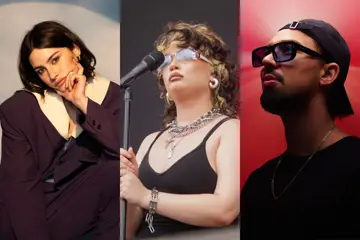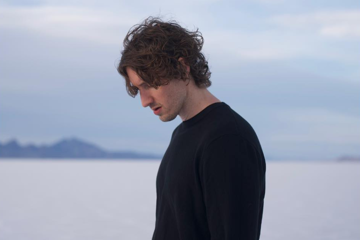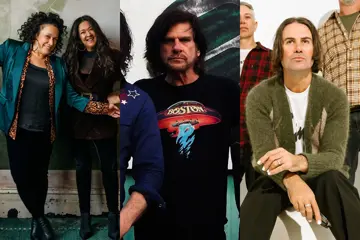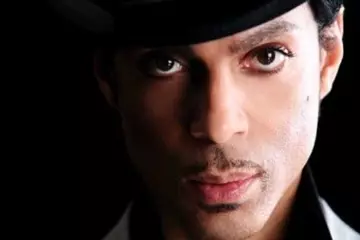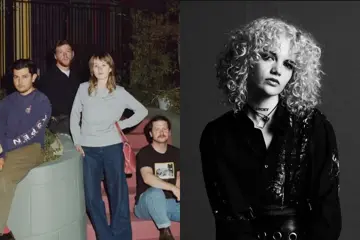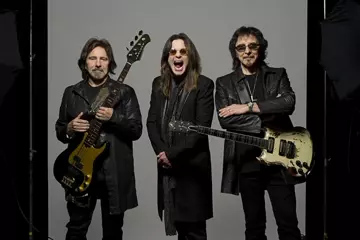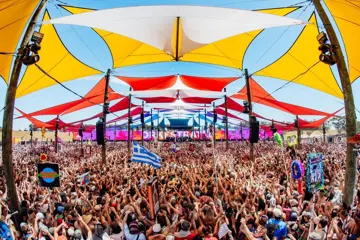1973 was not a great year for music. Indeed, as the legendary critic Ed Nimmervoll noted, “This was the worst year for singles music – filled with middle-of-the-road sentimentality. Record buyers rediscovered Perry Como and danced in the old-fashioned way with Charles Aznavour.”
The year’s biggest hits in Australia were Tie A Yellow Ribbon Round The Ole Oak Tree, Monster Mash and Perry Como’s For The Good Times and And I Love You So.
But 1973 was a landmark year for Australian albums, with the triple album Sunbury 1973, The Great Australian Rock Festival. Recorded by John French, it is the definitive document of the second Sunbury Festival.
And it was an audacious opening statement from the nascent Mushroom Records – their first album and the first Australian triple album.
“With Sunbury, we wanted to make a statement that Mushroom was a serious record label that we wanted the retailers, the media, the musicians, the public to take seriously and know we meant business for Australian music,” the label’s founder Michael Gudinski is quoted in Peter Evans’ Sunbury book.
Don't miss a beat with our FREE daily newsletter
Sunbury 1973 was held on January 27, 28 & 29, with a three-day ticket costing $8. It was a tribal gathering, with an estimated 30,000 people in the crowd.
Paul Hogan was the MC. He started by telling the crowd: “Now let’s get one thing straight, mums and dads – I’ve put a 44-gallon drum either side of the stage for the kids to put their marijuana and other drugs in, and they’re both empty.”
The event featured seven artists later inducted into the ARIA Hall of Fame –Johnny O’Keefe, Billy Thorpe, Lobby Loyde, Broderick Smith, Kerryn Tolhurst, John Bois and Ian Rilen.
The total budget for the bands was $12,545.
As Ed Nimmervoll pointed out, “The second Sunbury proved even bigger than the first. Performers and audience agreed they just had to be there. No international act required.”
It was the final all-Australian Sunbury.
“Sunbury,” said Gudinski, “was the start of people standing up and feeling proud of their own music.”
Author Murray Engleheart called Sunbury “the biggest outdoor pub on the planet”. It even inspired a song by The Fauves:
Released in April 1973, the Sunbury triple album cost $11.90. It was launched at Melbourne club Sebastian’s, with the catering courtesy of the Mushroom Growers’ Association, who provided hundreds of mushrooms (non-psychedelic).
So, what happened to the artists that set Sunbury alight 50 years ago?
Here are a dozen highlights of Sunbury ’73.
JOHNNY O’KEEFE
Track one on the Sunbury album is by the man who started rock ’n’ roll in Australia – Johnny O’Keefe.
“Appearing at the Sunbury music festival was possibly the biggest gamble of his career,” wrote JO’K’s biographer Damian Johnstone. “Could he cut it with a generation of music fans seemingly light years away from the patrons of the pub circuit he now commanded? Or would this be the finish of the big-time for O’Keefe? Many predicted the latter.”
The MC, Paul Hogan, introduced JO’K:
“Listen up, I’ve got a new kid for ya tonight. I’ve dug up this bloke around me suburb. He’s only new. Matter of fact, he run third in the talent quest out Dandenong the other week. But I want him to make his debut here tonight, so, like, shut up and give him a go. I mean, he’s nervous and he’s raw and he hasn’t got much talent, but he’s in there trying and working all the time. So give him a big warm welcome. Ah, and make him feel at home. His name’s Jimmy O’Keefe and he’s only new as I said, so give him all your best. Jimmy O’Keefe, give him a big welcome.”
JO’K was greeted by boos, beer cans and eggs. But he won over the crowd, with Lobby Loyde declaring, “When O’Keefe hit the stage, man, he was the greatest rock ’n’ roller that ever walked. He was the full million-dollar package. I don’t think anyone ever got near O’Keefe.”
Johnny O’Keefe died of a heart attack, aged 43, in October 1978.
FRIENDS
Mushroom’s first releases were singles, released the week after Sunbury ’73, by Madder Lake and a band called Friends.
Friends were fronted by Leo De Castro, a Kiwi who relocated to Australia in 1969. Michael Browning – who would later manage AC/DC – called De Castro “probably the most electrifying vocalist I’ve ever heard. But he was also big trouble … [though] it was hard to stay angry at a guy who could do Little Richard almost better than the guy himself.”
Friends’ contribution to the Sunbury album was a cover of Leonard Cohen’s Bird On The Wire and a De Castro original, La La Song.
Friends broke up in 1973. In 1975, the Johnny Rocco Band – fronted by De Castro – was the first to record Heading In The Right Direction, which Renée Geyer recorded later that year.
Leo De Castro moved to Tasmania in the ’80s. He later returned to Auckland, where he died in 2019, aged 70.
Friends bass player Duncan McGuire and drummer Mark Kennedy formed Ayers Rock later in 1973, who became the first Mushroom act to sign to an overseas label (A&M) – their debut album, Big Red Rock, was Mushroom’s first international release.
McGuire produced INXS’s self-titled debut album. He died of cancer in 1989. And Kennedy played with Marcia Hines and Renée Geyer.
THE ’69ERS
Sydney band The ’69ers were the clown princes of Sunbury. Fronted by Francis Butler and Peter Knox, they played a mix of rock ’n’ roll, jug band music and country swing and billed themselves as “the fabulous internationally famous ’69ers”.
Their contribution to the Sunbury ’73 album was a cover of The Kinks’ Harry Rag – complete with kazoo solo – which they had released as a single in August 1972.
In April 1973 – the same month the Sunbury album was released – the band sacked Butler and became Peter Knox’s New Improved ’69ers. Butler responded by forming Francis Butler’s Original ’69ers. Peter Knox’s New Improved ’69ers later changed their name to Omnibus and then Locoweed. But Knox rejoined Butler in his version of the ’69ers. They released one more single, Flash, before breaking up at the end of 1974.
Peter Knox became known as Izzy Foreal, fronting The Fabulous Zarsoff Bros, who called themselves “the Marx Brothers of rock ’n’ roll”. The name was inspired by ’69ers drummer Dave Ovenden, who would often make a public announcement at gigs: “A message for Mr Bluey Zarsoff – please refrain from leaving skid marks in the car park.” Knox died of a heart attack while jogging in Valery in NSW in June 2014. He was 65.
Knox inspired Australian writer and social commentator Van Badham, who said, “Meeting Izzy as an 18-year-old was the encounter that inspired the directions I took in my own life – artistic and political.”
Francis Butler released an album of religious songs, There Is No Escape, in 1978 and became an evangelist. He relocated his Christian ministry from Sydney to Houston, Texas in 1987. His website proclaims, “Jesus miraculously saved Frank out of the rock music lifestyle in 1976 and called him as an evangelist to build His church.
“At one time, Frank lived for rock ’n’ roll, but now lives for Jesus Christ, the Rock that never rolls.”
LOBBY LOYDE & COLOURED BALLS
Legend has it that Lobby Loyde (who was born John Baslington Lyde and was also known as Barry Lyde) was related to Oscar Wilde, with his great-grandmother Rebecca the illegitimate half-sister of the playwright.
Billy Thorpe called Loyde, “the godfather of heavy rock in this country”.
“He quickly became Australia’s first guitar hero,” Michael Browning observed.
The Purple Hearts’ bass player, Bob Dames, dubbed him Lobby – “because I would lobby the fuck out of people”. He added the “o” to his surname “because it rhymed better”.
Loyde’s signature song was G.O.D, which stood for “Guitar Over Drive” or “Guitar Over Dose”. He cited Beethoven and Wagner as inspirations.
Loyde played G.O.D when he did an unscheduled performance at Sunbury ’73 – at 3.30 am on January 29. He called it “the Fucked Band” – “you were fucked if you were in it and you were fucked if you weren’t”.
“We were off our minds,” Loyde later explained, “and we said to the stage roadies, ‘Turn it on, mate, we’re going to bloody play!’ And they said, ‘Everyone’s asleep.’ And we said, ‘Ah, they won’t be asleep for long!’”
Loyde later produced albums for Buster Brown, X, Machinations, Sunnyboys and Painters & Dockers, and spent a year playing bass in Rose Tattoo.
Cited as an inspiration by Kurt Cobain, Henry Rollins and Pavement’s Stephen Malkmus, Loyde was inducted into the ARIA Hall of Fame in 2006. Angry Anderson said: “More than anyone else, Lobby helped create the Australian guitar sound, long before Angus or Billy Thorpe or The Angels or Rose Tattoo. Lobby inspired Australian bands to step forward and play as loud and aggressively as they could. People are still trying to copy it today.”
Lobby Loyde died of lung cancer, aged 65, in April 2007.
Coloured Balls drummer Trevor Young survived the Black Saturday bushfires but lost all of his musical gear. He died of cancer five years later, in 2014.
MADDER LAKE
Madder Lake guitarist Brenden Mason and bass player Kerry McKenna went to Melbourne High with Michael Gudinski.
“In third form, our form teacher was Mr Harrowfield,” Mason recalls. “Possibly for convenience, he placed all the class in alphabetical order: Mason, McKenna … I have often thought that if my surname was Smith or Brown, Madder Lake would never have happened.”
Madder Lake’s Goodbye Lollipop was Mushroom’s first chart hit. 12lb. Toothbrush was the band’s biggest hit, reaching the Top 10 in Melbourne. “It’s got nothing to do with toothbrushes,” Mason explains. “A lot of our songs and lyrics had not a lot of relation to the actual title. 12lb. Toothbrush was kind of our joke on the DJs. We knew it would get a bit of radio play and they had to announce a song called 12lb. Toothbrush.”
Madder Lake and Billy Thorpe were the only acts to play at all four Sunbury Festivals. Madder Lake were the opening act at the first Sunbury in 1972; they were one of the headliners the following year.
Two weeks after Sunbury ’73, Madder Lake supported The Rolling Stones at Kooyong.
Madder Lake’s original lead singer, Mick Fettes, died in November 2016, aged 65. The band still performs – they did a 50th-anniversary show at the start of 2020 – with singer Michael O’Loughlin.
BAND OF LIGHT
Singer Phil Key moved to Australia from New Zealand in 1968 with The La De Da’s and appeared with them at the first Sunbury in 1972 but quit later that year and formed Band Of Light, a blues-based band with a spiritual side to their lyrics, reflected in the band’s logo – a yin and yang symbol set within two triangles.
The spiritual side didn’t sit comfortably with the rest of the band. “None of the songs fulfilled my need for rock ’n’ roll religion,” bass player Ian Rilen said. “I like singing about drinking and rooting and love and life.”
Band Of Light’s contribution to the Sunbury album was a cover of Messin’ With The Kid, which was first recorded by Junior Wells in 1960.
Rilen, slide guitarist Norm Roue and drummer Tony Buettel all quit Band Of Light in 1974, before the second and final Band Of Light album, The Archer.
Roue joined Buffalo, with Pete Wells. Buettel moved into record production, co-producing Uncanny X-Men’s debut EP, SaliveOne!, in 1982. Key died of a congenital heart condition in 1984.
Rilen joined Blackfeather in 1975 and was then a founding member of Rose Tattoo, writing their debut single, Bad Boy For Love. He quit to form X in 1977. In 2006, Rilen left his hospital bed for Rose Tattoo’s induction into the ARIA Hall of Fame. He died two months later, aged 59, from bladder cancer.
BILLY THORPE AND THE AZTECS
Billy Thorpe was seen as the King of Sunbury – the King of the Hill.
After an ill-fated UK tour – “They just didn’t know what they were looking at, they couldn’t relate to us,” recalls drummer Gil Matthews. “I reckon if we had gone to America at that point in time, the Aztecs now would be like AC/DC” – the Aztecs came home to play at Sunbury ’73.
Fans recall there was visible on-stage tension between Billy Thorpe and keyboard player Bruce Howard, who was a little under the weather. Howard left the band a couple of weeks later, replaced by former Aztecs piano man Warren “Pig” Morgan. Bass player Paul Wheeler also exited.
“It was like a Nuremberg rally – really loud and basic,” Broderick Smith said of the Aztecs at Sunbury ’73. “If you were looking for subtleties and nuances and pathos and poignancy then forget it! It was like, here are the tanks! This is blitzkrieg! This is not poetry time.”
Billy Thorpe was inducted into the ARIA Hall of Fame in 1991. He died of a heart attack, aged 60, in 2007. And with him went hopes of a Sunbury resurrection. “There was talk,” Matthews revealed. “Billy was a great driver of these things – he would go to people like Michael Chugg and talk them into it. With him not being around anymore, I just don’t think you’ll see that situation now, unfortunately.”
CARSON
The Go-Set review praised Broderick Smith’s performance at Sunbury ’73: “Broderick, his face contorted and out of control, was at his magnificent best – howling like a Wolf, muddy like a Water, little like a Walter, as he pranced, jumped and blew his way into an area where legends are born … his voice said things to every person in that huge crowd.”
But Sunbury ’73 was to be one of Carson’s final shows.
“We were dumped from EMI/Harvest,” Broderick Smith explains. “EMI, as the story goes, had been late entering the colour TV market. Consequently, they had taken a bath and a directive had appeared from London to cut costs everywhere. EMI’s number crunchers went to work and started to slash and burn. One of the first victims was EMI/Harvest. The entire label was killed off and all the acts dropped. It is the only time I have been killed by a TV.”
Broderick Smith formed The Dingoes with Country Radio’s Kerryn Tolhurst and John Bois, and Axiom’s Chris Stockley.
MATT TAYLOR
Matt Taylor was one of Mushroom’s first signings, alongside Madder Lake, Friends and MacKenzie Theory.
Brisbane To Beechworth – which Taylor played at Sunbury ’73 – was the story of his life to that point.
Taylor was instrumental in the careers of two legends of the music industry – Michael Gudinski and Glenn Wheatley.
Wheatley was the rhythm guitarist and then bass player in Taylor’s Brisbane band Bay City Union, from 1966 to ’68. And Gudinski’s big break was booking and managing Taylor’s band Chain when he was still a teenager.
“Look, Michael was going to become a multi multi-millionaire no matter whether I was part of his story,” Taylor says. “But everyone needs someone to have faith in them, to give them a break and that was us. I gave him a go.”
MACKENZIE THEORY
MacKenzie Theory followed the Aztecs on Saturday night – “the death slot”, breaking one of showbiz’s cardinal rules: You don’t follow Billy Thorpe.
But their set was seen as a triumph.
Unbeknown to Rob MacKenzie, representatives of the Australia Council for the Arts were in the Sunbury crowd. The recently elected Whitlam Government had instructed the Council to give a major grant to a rock musician. A couple of days after Sunbury, MacKenzie received a call – offering him an overseas study trip.
In the ’90s, MacKenzie was a member of the American ’50s revival band Sha Na Na.
GLENN CARDIER
Glenn Cardier grew up in Brisbane and became an art teacher. Festival Records spotted him when he appeared in a songwriting competition on Brian Henderson’s Bandstand in 1970.
He was signed by David Sinclair, who later signed Cold Chisel, and Cardier relocated to Sydney in 1971.
Like Rob MacKenzie and Country Radio’s Greg Quill, Cardier was a recipient of one of Gough Whitlam’s Council for the Arts grants. He went to the UK, where he stayed for four years.
He was managed by Aussie ex-pat Peter Gormley, who also managed Olivia Newton-John and Cliff Richard.
ONJ recorded Cardier’s song New-Born Babe on her 1976 album, Don’t Stop Believin’, and Ol’ 55 recorded Iridescent Pink Sock Blues on their triple platinum debut album, Take It Greasy.
Cardier played at Sunbury in 1972 and 1973.
Fun fact: As Sidney Hill, Cardier recorded Establishment Blues, which was the B-side of C’mon Aussie C’mon, which went to number one in 1979.
BAKERY
Perth band Bakery had the final song on the Sunbury triple album – Living With A Memory, written by the band’s former lead singer Mark Verschuer, who left in 1972.
Bakery guitarist and singer Peter Walker produced Cold Chisel’s self-titled debut in 1978. Walker was one of Ian Moss’s first guitar heroes. He also co-produced Mossy’s second solo album, 1991’s Worlds Away, and produced his 2018 self-titled set.
“I first saw Peter on GTK on the ABC in 1972 when he was playing in a band called Bakery,” Mossy recalls. “One of the things I liked about him, from a nerdy guitar outlook, was he was playing something different. Everyone at that time was playing a Les Paul, but he was playing a [Gibson] 335. Peter’s a great feel player. He’s an encyclopedia of chords, and he’s a genius at arrangements.”


